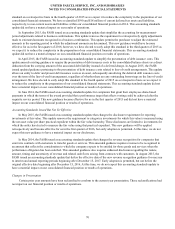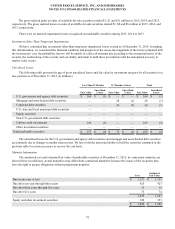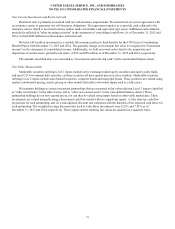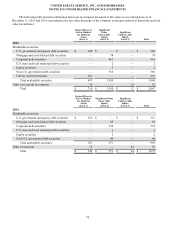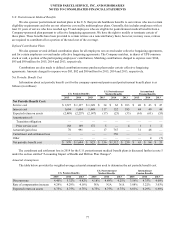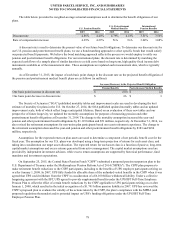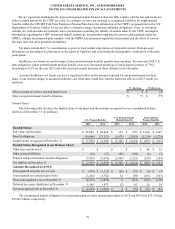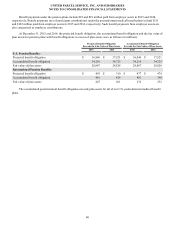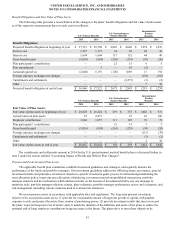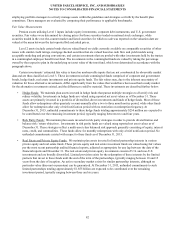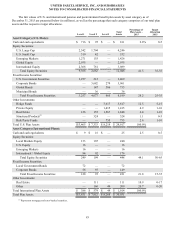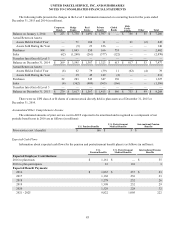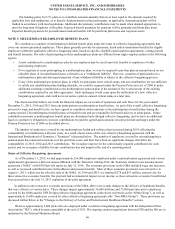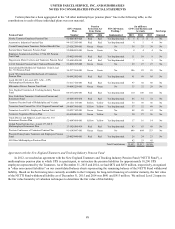UPS 2015 Annual Report Download - page 90
Download and view the complete annual report
Please find page 90 of the 2015 UPS annual report below. You can navigate through the pages in the report by either clicking on the pages listed below, or by using the keyword search tool below to find specific information within the annual report.
UNITED PARCEL SERVICE, INC. AND SUBSIDIARIES
NOTES TO CONSOLIDATED FINANCIAL STATEMENTS
78
The table below provides the weighted-average actuarial assumptions used to determine the benefit obligations of our
plans.
U.S. Pension Benefits
U.S. Postretirement
Medical Benefits
International
Pension Benefits
2015 2014 2015 2014 2015 2014
Discount rate 4.86% 4.40% 4.79% 4.18% 3.51% 3.56%
Rate of compensation increase 4.29% 4.29% N/A N/A 3.04% 3.08%
A discount rate is used to determine the present value of our future benefit obligations. To determine our discount rate for
our U.S. pension and postretirement benefit plans, we use a bond matching approach to select specific bonds that would satisfy
our projected benefit payments. We believe the bond matching approach reflects the process we would employ to settle our
pension and postretirement benefit obligations. For our international plans, the discount rate is determined by matching the
expected cash flows of a sample plan of similar duration to a yield curve based on long-term, high quality fixed income debt
instruments available as of the measurement date. These assumptions are updated each measurement date, which is typically
annually.
As of December 31, 2015, the impact of each basis point change in the discount rate on the projected benefit obligation of
the pension and postretirement medical benefit plans are as follows (in millions):
Increase (Decrease) in the Projected Benefit Obligation
Pension Benefits Postretirement Medical Benefits
One basis point increase in discount rate $ (60)$ (2)
One basis point decrease in discount rate $ 66 $ 3
The Society of Actuaries ("SOA") published mortality tables and improvement scales are used in developing the best
estimate of mortality for plans in the U.S. On October 27, 2014, the SOA published updated mortality tables and an updated
improvement scale, both of which reflect longer anticipated lifetimes. Based on an evaluation of these new tables and our
perspective of future longevity, we updated the mortality assumptions for purposes of measuring pension and other
postretirement benefit obligations at December 31, 2014. The change to the mortality assumption increased the year-end
pension and other postretirement benefit obligations by $1.119 billion and $51 million, respectively. At December 31, 2014, we
also revised the retirement assumptions for non-union plan participants based on recent retirement experience. The change to
the retirement assumption decreased the year-end pension and other postretirement benefit obligations by $383 and $234
million, respectively.
Assumptions for the expected return on plan assets are used to determine a component of net periodic benefit cost for the
fiscal year. The assumption for our U.S. plans was developed using a long-term projection of returns for each asset class, and
taking into consideration our target asset allocation. The expected return for each asset class is a function of passive, long-term
capital market assumptions and excess returns generated from active management. The capital market assumptions used are
provided by independent investment advisors, while excess return assumptions are supported by historical performance, fund
mandates and investment expectations.
On September 25, 2015, the Central States Pension Fund ("CSPF") submitted a proposed pension suspension plan to the
U.S. Department of Treasury under the Multiemployer Pension Reform Act of 2014 ("MPRA"). The CSPF plan proposes to
make retirement benefit reductions to the CSPF participants, including to the benefits of UPS employee participants retiring on
or after January 1, 2008. In 2007, UPS fully funded its allocable share of the unfunded vested benefits in the CSPF when it was
agreed that UPS could withdraw from the CSPF in consideration of a $6.100 billion withdrawal liability. Under a collective
bargaining agreement with the IBT, UPS agreed to provide supplemental benefits under the UPS/IBT Full-Time Employee
Pension Plan to offset the effect of certain benefit reductions by the CSPF applicable to UPS participants retiring on or after
January 1, 2008, which resulted in the initial recognition of a $1.701 billion pension liability in 2007. UPS has reviewed the
CSPF’s proposed plan to evaluate the validity of the actions taken by the CSPF, the plan’s compliance with the MPRA (and
proposed regulations thereunder) and its potential impact on UPS’s funding obligations under the UPS/IBT Full-Time
Employee Pension Plan.




